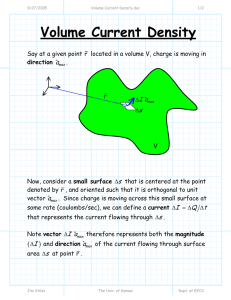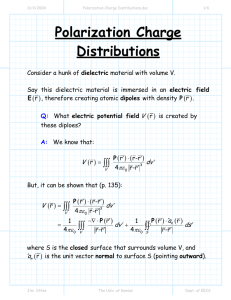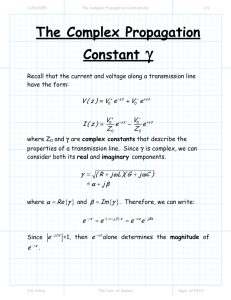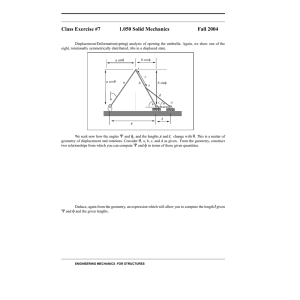4-4 E-field Calculations using Coulomb`s Law
advertisement
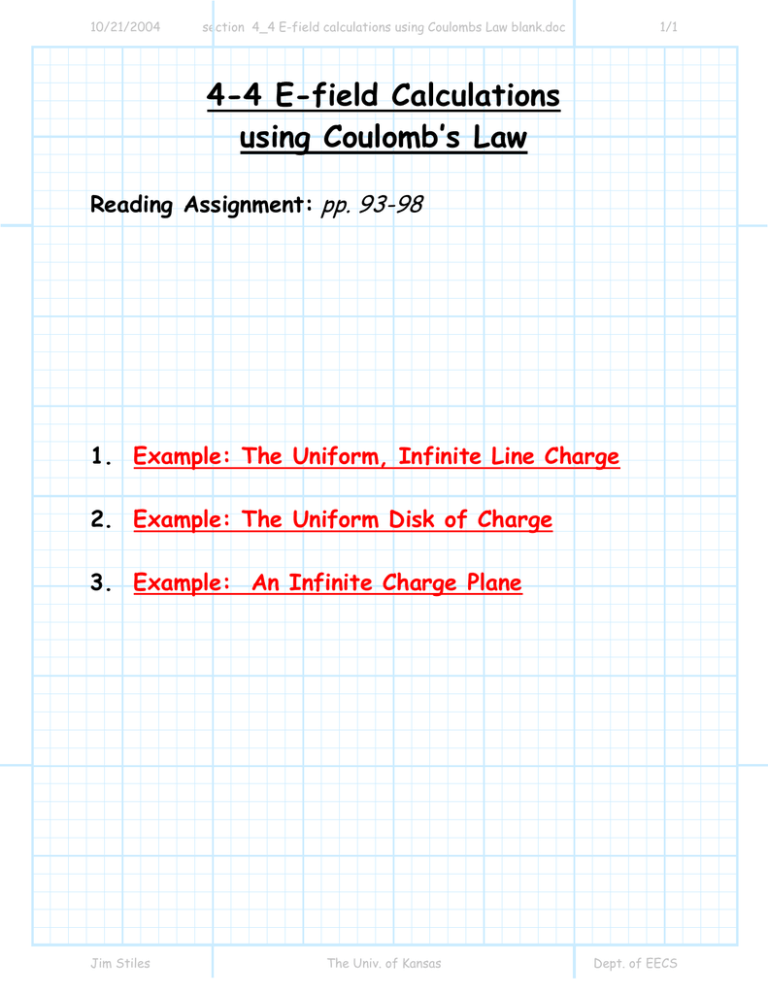
10/21/2004 section 4_4 E-field calculations using Coulombs Law blank.doc 1/1 4-4 E-field Calculations using Coulomb’s Law Reading Assignment: pp. 93-98 1. Example: The Uniform, Infinite Line Charge 2. Example: The Uniform Disk of Charge 3. Example: An Infinite Charge Plane Jim Stiles The Univ. of Kansas Dept. of EECS 10/21/2004 The Uniform Infinite Line Charge.doc 1/5 The Uniform, Infinite Line Charge Consider an infinite line of charge lying along the z-axis. The charge density along this line is a constant value of ρ A C/m. Q: What electric field E ( r ) is produced by this charge distribution? A: Apply Coulomb’s Law! We know that for a line charge distribution that: E (r ) = ∫ C r r′ ρ A ( r′ ) r-r′ d A′ 4πε 0 r-r′ 3 E (r ) r-r′ ρA Jim Stiles The Univ. of Kansas Dept. of EECS 10/21/2004 The Uniform Infinite Line Charge.doc 2/5 Q: Yikes! How do we evaluate this integral? A: Don’t panic! You know how to evaluate this integral. Let’s break up the process into smaller steps. Step 1: Determine d A′ The differential element d A′ is just the magnitude of the differential line element we studied in chapter 2 (i.e., d A′ = d A′ ). As a result, we can easily integrate over any of the seven contours we discussed in chapter 2. The contour in this problem is one of those! It is a line parallel to the z-axis, defined as x’ =0 and y’ =0. As a result, we use for d A′ : d A′ = ˆaz dz ′ = dz ′ Step 2: Determine the limits of integration This is easy! The line charge is infinite. Therefore, we integrate from z ′ = −∞ to z ′ = ∞ . Step 3: Determine the vector r-r′ . Since for all charge x’ = 0 and y’ =0, we find: r-r′ = = ( xˆa ( xˆa ) ( ) − z ′ˆa x ˆ y + za ˆ z − x′ˆax + y ′ˆay + z ′ˆaz + ya x ˆ y + za ˆz + ya ) z ˆ y + ( z − z ′ ) ˆaz = xˆax + ya Jim Stiles The Univ. of Kansas Dept. of EECS 10/21/2004 The Uniform Infinite Line Charge.doc Step 4: Determine the scalar r-r′ 3/5 3 2 Since r-r′ = x 2 + y 2 + ( z − z ′ ) , we find: 3 2 r-r′ = ⎡⎣x + y + ( z − z ′ ) ⎤⎦ 2 2 3 2 Step 5: Time to integrate ! E (r ) = ∫ C = ρ A ( r′ ) r-r′ d A′ 3 4πε 0 r-r′ 1 4πε 0 ρA = 4πε 0 = ∫ρ −∞ ∞ ∫ −∞ A ⎡x 2 + y 2 + ( z − z ′ ) ⎤ ⎣ ⎦ x ˆax + y ˆay + ( z − z ′ ) ˆaz 2 2 ⎡x 2 + y 2 + ( z − z ′ ) ⎤ ⎣ ⎦ ρ A ( x ˆax + y ˆay ) 4πε 0 ρ ˆa + A z 4πε 0 = x ˆax + y ˆay + ( z − z ′ ) ˆaz ∞ ∫ 2 dz ′ dz ′ dz ′ ∞ ∫ ⎡x 2 + y 2 + ( z − z ′ )2 ⎤ ⎣ ⎦ ( z − z ′ ) dz ′ 2 ⎡ ′ ⎤ ⎣x + y + ( z − z ) ⎦ 2 ρ A ( x ˆax + y ˆay ) 4πε 0 2 −∞ ∞ −∞ 3 3 2 3 3 2 2 2 +0 x + y2 2 ρ A ( x ˆax + y ˆay ) = x2 + y2 2πε 0 Jim Stiles The Univ. of Kansas Dept. of EECS 10/21/2004 The Uniform Infinite Line Charge.doc 4/5 This result, however, is best expressed in cylindrical coordinates: ˆy xˆax + ya ρ cosφ ˆax + ρ sinφ ˆay ρ2 cosφ ˆax + sinφ ˆay = ρ = x2 + y2 And with cylindrical base vectors: cosφ ˆax + sinφ ˆay ρ = + + = + + 1 cosφ ˆa ( ρ 1 ) ⋅ ˆaρ + sinφ ˆay ⋅ ˆaρ ˆaρ ( cosφ ˆa ⋅ ˆaφ + sinφ ˆay ⋅ ˆaφ ˆaφ cosφ ˆa ( ρ ⋅ ˆaz + sinφ ˆay ⋅ ˆaz ˆaz ρ x 1 1 x ) ) ( cos φ + sin φ ) ˆa ρ 1 ρ 1 ρ ˆaρ = ρ Jim Stiles x 2 2 ρ ( -cosφ sinφ + sinφ cosφ ) ˆaφ ( cosφ ( 0 ) + sinφ ( 0 ) ) ˆaz The Univ. of Kansas Dept. of EECS 10/21/2004 The Uniform Infinite Line Charge.doc 5/5 As a result, we can write the electric field produced by an infinite line charge with constant density ρ A as: E (r ) = ρ A âρ 2πε 0 ρ Note what this means. Recall unit vector âρ is the direction that points away from the z-axis. In other words, the electric field produced by the uniform line charge points away from the line charge, just like the electric field produced by a point charge likewise points away from the charge. It is apparent that the electric field in the static case appears to diverge from the location of the charge. And, this is exactly what Maxwell’s equations (Gauss’s Law) says will happen ! i.e.,: ∇ ⋅ E (r ) = ρv ( r ) ε0 Note the magnitude of the electric field is proportional to 1 ρ , therefore the electric field diminishes as we get further from the line charge. Note however, the electric field does not diminish as quickly as that generated by a point charge. Recall in that case, the magnitude of the electric field diminishes as 1 r2 . Jim Stiles The Univ. of Kansas Dept. of EECS 10/21/2004 The Uniform Disk of Charge.doc 1/5 The Uniform Disk of Charge Consider a disk radius a, centered at the origin, and lying entirely on the z =0 plane. E (r ) r r-r′ ρs r′ This disk contains surface charge, with density of ρs C/m2. This density is uniform across the disk. Let’s find the electric field generated by this charge disk! From Coulomb’s Law, we know: E (r ) = Jim Stiles ∫∫S ρs ( r′ ) r-r′ ds ′ 4πε 0 r-r′ 3 The Univ. of Kansas Dept. of EECS 10/21/2004 The Uniform Disk of Charge.doc 2/5 Step 1: Determine ds’ This disk can be described by the equation z’ = 0. That is, every point on the disk has a cordinate value z’ that is equal to zero. This is one of the surfaces we examined in chapter 2. The differential surface element for that surface, you recall, is: ds ′ = dsz = ρ ′ d ρ ′ d φ ′ Step 2: Determine the limits of integration . Note over the surface of the disk, ρ ′ changes from 0 to radius a, and φ ′ changes from 0 to 2π . Therefore: 0 < ρ′ < a Step 3: 0 < φ ′ < 2π Determine vector r-r′ . We know that z’ = 0 for all charge, therefore we can write: r-r′ = = ( xˆa ( xˆa ) ( ) − ( x′ˆa x ˆ y + za ˆ z − x′ˆax + y ′ˆay + z ′ˆaz + ya x ˆ y + za ˆz + ya x + y ′ˆay ) ) ˆz = ( x-x′ ) ˆax + ( y − y ′ ) ˆay + za Since the primed coordinates in ds’ are expressed in cylindrical coordinates, we convert the coordinates to get: Jim Stiles The Univ. of Kansas Dept. of EECS 10/21/2004 The Uniform Disk of Charge.doc ( ) ( ˆ y + za ˆ z − x′ˆax + y ′ˆay r-r′ = xˆax + ya 3/5 ) = ( x − x') ˆax + ( y − y ′ ) ˆay + z ˆaz = ( x − ρ ′ cosφ ′ ) ˆax + ( y − ρ ′ sinφ ′ ) ˆay + z ˆaz Step 4: Determine r-r′ 3 We find that: r-r′ 3 2 2 = ⎡( x-ρ ′cosφ ′ ) + ( y − ρ ′sinφ ′ ) + z 2 ⎤ ⎣ ⎦ 3 2 Step 5: Time to integrate ! E (r ) = ∫∫S ρs ( r′ ) r-r′ ds ′ 4πε 0 r-r′ 3 ρs = 4πε 0 2π a ∫∫ 0 0 ( x-ρ ′cosφ ′ ) ˆax + ( y − ρ ′sinφ ′ ) ˆay + z ˆaz ⎡( x-ρ ′cosφ ′ )2 + ( y − ρ ′sinφ ′ )2 + z 2 ⎤ ⎣ ⎦ 3 2 ρ ′d ρ ′d φ ′ Yikes! What a mess! To simplify our integration let’s determine the electric field E ( r ) along the z-axis only. In other words, set x = 0 and y = 0. Jim Stiles The Univ. of Kansas Dept. of EECS 10/21/2004 The Uniform Disk of Charge.doc E ( x=0,y=0,z ) = ∫∫ S 4/5 ρs ( r′ ) r-r′ ds ′ 3 4πε 0 r-r′ ρs 2π a ( 0 − ρ ′cosφ ′ ) aˆx + ( 0 − ρ ′sinφ ′ ) aˆy − zaˆz ρ ′d ρ ′d φ ′ = 3 2 2 2 4πε 0 ∫0 ∫0 ⎡ ( 0 − ρ ′cosφ ′) + ( 0 − ρ ′sinφ ′ ) + z 2 ⎤ ⎣ ⎦ − ρs 2π a ( ρ ′cosφ ′ ) aˆx + ( ρ ′sinφ ′ ) aˆy − zaˆz ρ ′d ρ ′d φ ′ = 3 ∫ ∫ 4πε 0 0 0 ⎡⎣ ρ ′2 + z 2 ⎤⎦ 2 2π a ( ρ ′cosφ ′ ) ρ ′d ρ ′d φ ′ ρs aˆx ∫ ∫ = 3 4πε 0 0 0 ⎡⎣ ρ ′2 + z 2 ⎤⎦ 2 2π a ( ρ ′sinφ ′ ) ρ ′d ρ ′d φ ′ − ρs aˆy ∫ ∫ + 3 4πε 0 0 0 ⎡⎣ ρ ′2 + z 2 ⎤⎦ 2 2π a − ρs z ρ ′d ρ ′d φ ′ aˆz ∫ ∫ + 4πε 0 0 0 ⎡ ρ ′2 + z 2 ⎤ 32 ⎣ ⎦ Note that since: 2π 2π 0 0 ∫ sin φ d φ = 0 = ∫ cos φ d φ The first two terms (Ex and Ey) are equal to zero. Integrating the last term, we get: ⎧ ρ ⎡ ⎤ z ⎪ s ˆaz ⎢1 − ⎥ ⎪ 2ε 0 z 2 + a2 ⎦ ⎣ ⎪ E ( x=0,y=0,z ) = ⎨ ⎪ ⎤ z ⎪ ρs ˆa ⎡ −1 − ⎥ 2 2 ⎪ 2ε 0 z ⎣⎢ z a + ⎦ ⎩ Jim Stiles The Univ. of Kansas if z > 0 if z < 0 Dept. of EECS 10/21/2004 The Uniform Disk of Charge.doc 5/5 From this expression, we can conclude two things. The first is that above the disk (z > 0), the electric field points in the direction ˆaz , and below the disk (z < 0), it points in the direction - ˆaz . What a surprise (not)! The electric field points away from the charge. It appears to be diverging from the charged disk (as predicted by Gauss’s Law). Likewise, it is evident that as we move further and further from the disk, the electric field will diminish. In fact, as distance z goes to infinity, the magnitude of the electric field approaches zero. This of course is similar to the point or line charge; as we move an infinite distance away, the electric field diminishes to nothing. Jim Stiles The Univ. of Kansas Dept. of EECS 10/21/2004 An Infinite Charge Plane.doc 1/3 An Infinite Charge Plane Say that we have a very large charge disk. So large, in fact, that its radius a approaches infinity ! What electric field is created by this infinite plane? Q: A: We already know! Just evaluate the charge disk solution for the case where the disk radius a is infinity. In other words: ⎧ ⎤ ρ ⎡ z ⎪ ˆaz s ⎢1 − ⎥ ⎪ 2ε 0 ⎣ z 2 + a2 ⎦ ⎪ lim E ( x=0,y=0,z ) = ⎨ a →∞ ⎪ ⎤ z ⎪ˆa ρs ⎡ −1 − ⎥ 2 2 ⎪ z 2ε 0 ⎢⎣ + z a ⎦ ⎩ ⎧ ρs ⎪ 2ε ˆaz ⎪⎪ 0 =⎨ ⎪ −ρ ⎪ s ˆaz ⎪⎩ 2ε 0 if z > 0 if z < 0 if z > 0 if z < 0 Therefore, the electric field produced by an infinite charge plane, with surface charge density ρs , is: Jim Stiles The Univ. of Kansas Dept. of EECS 10/21/2004 An Infinite Charge Plane.doc ⎧ ρs ⎪ 2ε ˆaz ⎪⎪ 0 E (r ) = ⎨ ⎪ −ρ ⎪ s ˆaz ⎪⎩ 2ε 0 2/3 if z > 0 if z < 0 Think about what this says! * First, we note that the electric field points away from the plane if ρs is positive, and toward the plane if ρs is negative. * Second, we notice that the magnitude of the electric field is a constant—the magnitude is independent of the distance from the infinite plane! ρs > 0 Jim Stiles The Univ. of Kansas Dept. of EECS 10/21/2004 An Infinite Charge Plane.doc 3/3 The reason for this result is, that no matter how far you are (i.e., |z|) from the infinite charge plane, you remain infinitely close to plane, when compared to its radius a. We will find these results are useful when we study the behavior of a parallel plate capacitor. Jim Stiles The Univ. of Kansas Dept. of EECS
